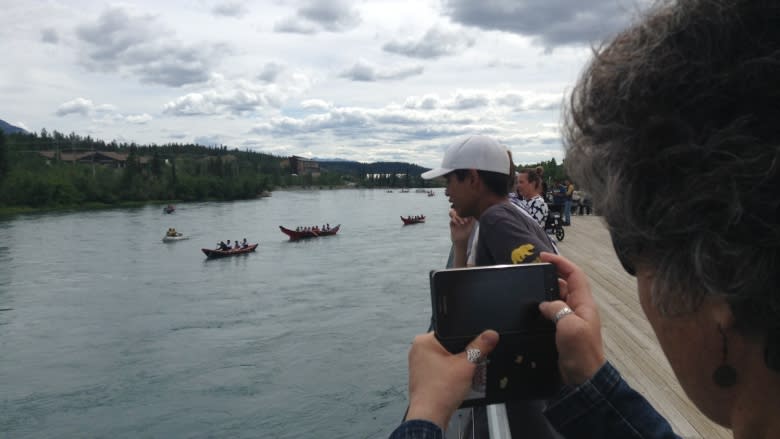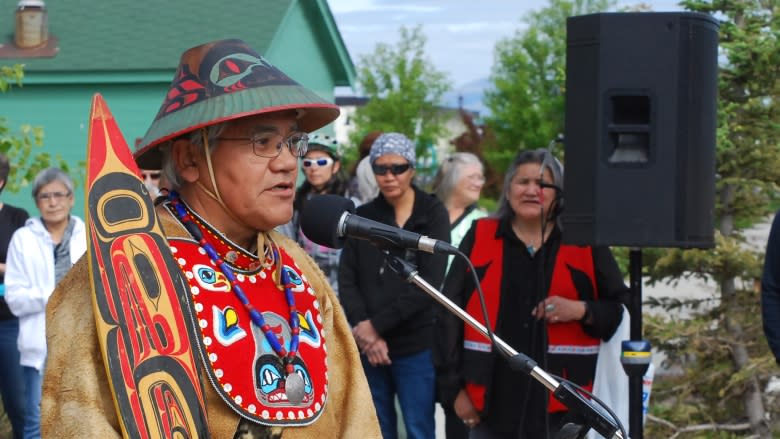Paddling with their ancestors: Yukon First Nations hit the ocean in traditional canoe
Members of the Champagne/Aishihik First Nations in Yukon never thought they would paddle a traditional Tlingit dugout canoe, especially on the ocean.
So Chief Steve Smith couldn't say no to the opportunity for his First Nations' to travel to this year's Celebration in Juneau, Alaska — a biennial gathering of Alaska, B.C. and Yukon Indigenous traditional dancers — in a traditional canoe.
"It started last year, when the 'Voices Across the Water' project happened in Whitehorse, and the Champagne and Aishihik First Nations were selected as one of the communities that was going to be gifted one of the vessels," Smith said.
It was a gift from the Yukon First Nations Culture and Tourism Association.
Smith says Master Carver Wayne Price, from Haines Alaska, carved the canoe with the help of apprentices, and Price didn't want to see the dugout canoe sit in a museum. He suggested paddling it to Celebration the following year.
First there were some challenges to overcome, though.
Smith says during the official launch of the dugout canoe last year, the vessel felt very unstable.
"The canoe still hadn't found its legs, so to speak," Smith said.
This spring, Price made some improvements, such as lowering the seats and widening the vessel by stretching it out, bringing the centre of gravity lower and placing sand bags on the bottom for ballast.
Smith says they then tested the canoe out on Pine Lake, and noticed a big improvement. That's when people started to get serious about making the 160-kilometre ocean trip.
Starting their journey
Nine Champagne and Aishihik First Nations members jumped at the chance to be part of the historic trip.
On June 3, they arrived in Haines, Alaska, to start their epic voyage. Along with the smaller dugout canoe, there would be two larger ones making the journey. The First Nations also chartered an ocean-going boat to travel along for safety and support.
The paddlers put the canoes in the water at 4 a.m. that first morning, when the tide was high.
"It was an amazing experience," says Richard Smith, one of the paddlers.
He recalls canoe leader Wayne Price telling the paddlers before setting off that "each person was there for a reason, and we had to discover that reason — it was up to us to paddle, and find out what each person's reason for being there."
Smith says Price told the paddlers they all would see the magic on the water — and Smith says he was right.
"I definitely seen something," said Smith.
Smith was paddling in one of the two larger canoes that first day, and he says he kept a close eye on the smaller spruce dugout canoe. He was still unsure of its seaworthiness.
"I heard it was really tippy when they took it out, so I kind of had my doubts if we could make it through the seas," he said.
Some ups and downs
The sea was calm that first day, but things would change on day two.
"We were paddling for a good two to three hours, and as we paddled, the waves got bigger and bigger and bigger," recalled Smith.
He says some of his group got seasick but he kept paddling. He says he thought about his ancestors a long time ago and how they would not have had a support boat.
"We were kind of on a strait where there was no place to land, so the support boat that was towing us at some points," he said.
The boats were lifted high on the ocean swells.
"I was looking up at [the other boat], and other points I was looking down at it, and actually our canoe would be surfing down the waves behind it — and we would almost pass the support boat," says Smith.
The canoes stayed upright, though, which Smith sees as "testament to the design of those canoes, and that technology that our ancestors had."
Finding the magic
Even in the big water, Smith says he felt at ease in the little dugout canoe.
"During the eight-foot swells, I kind of looked over and there was this humpback whale. It was quite the large whale, and it kind of surfaced about a half a mile out, off our starboard side," said Smith.
"And just to witness that was awesome — and it seemed to just kind of stay with us for a half hour."
Smith says the whale briefly disappeared but then showed up again in front of their canoe.
"It seemed like it was leading the way, you know, it made me feel a lot better. There is a connection — it's a connection with a higher power, whether it be the Creator, or nature. Seeing that being there is an incredible experience — there is nothing like it."
Wayne Price has now done the ocean trip from Haines to Juneau four times.
"Traditional boats arriving the traditional way to a traditional village site created by the true elders of the land is something that is touching a piece of our past," said Price.
Arriving at Auke Bay, Juneau
The last day of paddling brought a sense of accomplishment, Smith said.
The group tied their vessels together and paddled to shore. The local First Nations at Auke Bay in Juneau sang a welcoming song to them.
Chief Steve Smith was there to greet them.
"It was really emotional," said Chief Smith. "And then, of course, being with the paddlers you could just feel the pride and the excitement they had when they were coming ashore.
"Each one of them could carry a big bull moose out by themselves — that's how much energy and power they had."
Richard Smith and the rest of the paddling crew agree — it was an amazing journey.
He says the next time he sees the dugout canoe displayed in the Da Ku Cultural Centre in Haines Junction, Yukon, he is going to look at it a whole lot differently.
"It proved itself. It kept up with the big canoes, and actually excelled in the rough water — it left the big canoes behind," Richard Smith said.
"There is no worries with that canoe now, I know what those canoes can do."
Smith say he can't wait make the trip again — to the next Celebration, in two years.


